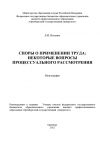Правообладателям!
Представленный фрагмент книги размещен по согласованию с распространителем легального контента ООО "ЛитРес" (не более 20% исходного текста). Если вы считаете, что размещение материала нарушает ваши или чьи-либо права, то сообщите нам об этом.Читателям!
Оплатили, но не знаете что делать дальше?
Текст бизнес-книги "Environmental crimes in a transnational context. Topical issues of international environmental disputes as a risk of threat to the world legal order"
Автор книги: Naili Pkhikidze
Раздел: Юриспруденция и право, Наука и Образование
Возрастные ограничения: +16
Текущая страница: 2 (всего у книги 3 страниц)
&2 International law and politics
International law is always inseparably linked with the politics of states. It is a continuation of their policy, fixed for a certain, often very long period, in the form of norms that create a legal obligation for these states to act exactly as they agreed in their agreements.
Throughout the history of international law, it has been based on the principle that the ancient Romans formulated as “pacta sunt servanda” – “treaties must be observed”. In contrast to the situation within the state, where the observance of law is ensured by the state apparatus in international relations, where there is no supranational power, states are forced to take their protection into their own hands when their rights are violated. At the same time, they seek support from other states, interested in maintaining the authority and effectiveness of international law, in order to jointly resort to sanctions or other coercive measures to restore violated rights. Currently, these actions of states are regulated by the UN Charter.
By being closely connected with politics, international law itself was in the past and currently remains a field of acute political struggle between various groups of states for the development and application of its institutions and norms in accordance with their interests.
In the era of Ancient Rome, international law reflected the relations of the hegemony of Ancient Rome and its subordinate peoples that existed at that time, in the Middle Ages it determined the relations of states – suzerains and vassals, and at a later time – the relationship of European monarchies with each other.
In the 20th century, there was a significant democratization of international relations, and, nevertheless, at the turn of the 20th and 21st centuries, some of the most developed states seek to limit the effect of the sovereignty of other countries, proving that in the era of globalization and economic and technological progress, the borders between countries are erased. Some authorities and groups of NATO states (this is a military-political bloc, the North Atlantic Treaty Organization, the North Atlantic Alliance (Eng. North Atlantic Treaty Organization, NATO;) – uniting most of the countries of Europe (including Turkey), the United States of America and Canada) lay claim to the exclusive right to maintain Western-style order and democracy in various parts of the world. Under the pretext of “humanitarian intervention”, they are ready to interfere in the internal affairs of other countries, acting as an international policeman. Often, the “struggle for the right” undergoes along the line of dividing the interests of the countries of the developed North and the developing South. Unfortunately, the attempts of individual states to ignore the norms of international law and sometimes directly violate them, have not gone away, which ultimately has a destructive effect on the ecology of the regions.
&3 The rights and power
The basis for the preservation of the world and the planet’s ecosystem is the international legal system provided for in the UN Charter. The UN Security Council has the primary responsibility for maintaining international peace and security in all aspects. In carrying out this task, the Security Council acts on behalf of all UN member states. The UN has the right “to take effective collective measures for the prevention and removal of threats to the peace and for the suppression of acts of aggression or other breaches of the peace, and to bring about by peaceful means, and in conformity with the principles of justice and international law, adjustment or settlement of international disputes or situations which might lead to a breach of the peace”. The realism laid down in the UN Charter lies in the fact that the composition of the Security Council, authorized to take such measures, up to forced ones, includes five great powers – permanent members of the council, which, subject to their consent, are able to ensure the fulfillment of the peacekeeping tasks assigned to the UN.
At the same time, the UN has a democratic system of annual discussion of all world problems in the main body – the General Assembly, where all member states participate in the adoption of recommendatory decisions with the right to vote on the basis of the principle of their sovereign equality. This system of UN, although it seems to require constant updating, is on the whole the most advanced stage in the development of modern international law.
In accordance with the principles of the UN Charter, states have developed and put into effect many treaties that determine the current state of international relations. Such important treaties include agreements between Russia (USSR) and the United States on the reduction of strategic armament, the Treaty on the Non-proliferation of Nuclear Weapons, treaties on the prohibition of nuclear-weapon tests, agreements on the non-deployment of nuclear weapons in outer space, the Antarctic Treaty, agreements on nuclear-weapon-free zones in various regions of the world, treaties on NATO, the CIS (The CIS countries are the Commonwealth of Independent States (CIS) established in December 1991. The CIS unites: the Republic of Azerbaijan, the Republic of Armenia, the Republic of Belarus, the Republic of Kazakhstan, the Kyrgyz Republic, the Republic of Moldova, the Russian Federation, the Republic of Tajikistan, the Republic of Uzbekistan and Ukraine) ,the European Community, agreements on regional integration associations, the OSCE Final Act, Vienna Conventions on Diplomatic and Consular Relations, Statutes of the UN Specialized Agencies, Universal Declaration of Human Rights, the International Covenants on Civil and Political, Economic, Social and Cultural Rights, United Nations Convention on the Law of the Sea of 10 December 1982, agreements on the protection of the environment and natural resources and so on.
The listed and many other agreements and declarations, as well as decisions of the UN and its international organizations, customs, recognized as legal norms, and decisions of international judicial bodies, form a general system of international law, within framework of which international relations are carried out today in all spheres of humankind existence.
&4 General provisions and the concept of international law of environmental protection
Surrounding Nature Environment – a complex of natural systems, natural objects and natural resources, including atmospheric air, water, land, subsoil resources, flora and fauna, as well as climate in their interconnection and interaction.
A favorable natural environment – such a state of natural objects that form the environment created by human being, as well as the quality of life and conditions that meets the legally established standards and regulations regarding its cleanliness, resource intensity, ecological sustainability, species diversity and aesthetic richness.
Protection of the natural environment – activities to preserve and restore (if it is violated) a favorable state of the ambient environment, prevent its degradation in the process of social development and maintain ecological balance.
The concept and resources of international environmental law.
International environmental law – a set of international legal principles and norms, regulating international relations regarding the protection of the environment from harmful effects, the rational use of its individual elements in order to ensure optimal conditions for the life and health of individuals, as well as the very existence of mankind as a whole.
Significance of international environmental law
The access to regulating relations of the issues of the international level regarding the environmental protection is conditioned by two main factors: the development of scientific and technological progress, a sharp increase in the human population, which leads to an imbalance in world environmental ties (today, humankind does not possess natural enemies capable of regulating its population).
Principles of international environmental law.
The principles of international legal regulation are generally divided into three groups: General (generally recognized) principles of international law; The principles of international law, having environmentally friendly importance; Special (sectoral) principles of international environmental law.
Special principles, formulated in the Stockholm Declaration of 1972, the World Charter for Nature adopted by the General Assembly on October 28, 1982, the Rio de Janeiro Declaration on Environment and Development of 1992 and other documents. The following basic principles should be highlighted:
1. The principle of rational use of natural resources, which obliges states to manage and use natural resources in such a way as not to damage the integrity of ecological systems, as well as to carry out a series of activities for the reproduction and renewal of natural resources (Convention for the Conservation of Antarctic Marine Living Resources 1980, United Nations Convention on the Law of the Sea 1982).
2. The principle of preventing environmental pollution means, that states should not pollute the ambient environment by bringing in various harmful substances into it, which, due to their danger or due to their large amount, exceed the ability of the ambient environment to neutralize and restore themselves. States are obliged by their actions not to transfer damage or hazard from one area to another, directly or indirectly, or to transform one type of pollution into another.
3. The principle of the sovereignty of states over their natural resources means the sovereign right of states to develop their own natural resources in accordance with their policies in the field of nature management, environmental protection and development. But it no longer has an absolute character.
4. The principle of doing no harm to the environment beyond the limits of national jurisdiction designates certain boundaries, but the exercise by the state of sovereignty over natural resources. It entails a requirement for states to ensure that activities carried out under their jurisdiction or control do not cause damage to the ambient environment of other States or areas. At the same time, even the existence of an armed conflict does not exempt the parties from fulfilling this requirement. If this institution were developed, and there was a sensitive scale for assessing damage to the ambient environment, then this would ensure the implementation of an appropriate environmental policy of each state.
5. The principle of protecting the ambient environment during military conflicts follows directly from the abovementioned. It is most fully formulated in the Convention on the Prohibition of Military or any other Hostile Use of Environmental Modification Techniques of 1976.
6. The principle of environmental impact assessment. In recent years, the number of universally recognized principles of international environmental law of a preventive nature has increased, i.e. not related to compensation for harm already inflicted, but aimed at some kind of preventive measures. This principle was laid down in the Convention on Environmental Impact Assessment in a Transboundary Context of 1991, the United Nations Convention on the Law of the Sea of 10 December 1982 (Article 206), as well as in numerous regional treaties – the Regional Convention for the Conservation of the Red Sea Region and the Gulf of Aden Environment of 1982, Convention for the Protection and Development of the Marine Environment of the Wider Caribbean Region of 1983 and so on.
7. The principle of liability for damage to environmental systems of other states or international spaces.
The subject of international environmental law.
The formation of the branch of international law – the international environmental law was generated on the basis of the principle “Use your own so as not to harm another”. Issues of protection and use of the ambient environment are regulated by national legislation as long as they do not go beyond the territorial boundaries of the state. International environmental law has an independent subject of legal regulation – international environmental relations, which can be divided into three groups:
– Relationships to prevent and limit harmful effects on the state of the ambient environment, which can only be resolved by the efforts of the entire international community (pollution of the World Ocean, air basin, environmental pollution during military conflicts and so on).
– Ensuring the rational use of international natural resources.
– Protection of unique natural objects by their conservation from human economic impact (environmental immunities).
Subjects of international environmental law.
The subjects of international environmental law include: states, international organizations, international non-governmental organizations.
States are the main subject of law. Several classifications of states-subjects of international environmental law have been specified in the scientific literature:
1) States, that are the most environmentally vulnerable and states, that are most environmentally friendly;
2) Developed and developing states, which are characterized not only by a different degree of independence in solving environmental problems, but also by different substantive interests in this area;
3) States, that are affected by the same natural factors due to their geographical location and states that, due to their geographical location, are affected by various natural factors, which influences on the content of the adopted international legal documents.
Despite the difference in the status of states, the implementation of specific legal and regulatory regulation is based on common principles. One of the trends in international environmental law has been the growing importance of international and international non-governmental organizations as subjects of international environmental law.
International environmental law is a relatively young branch of international law, that has emerged from such branches of international law as international maritime, air, space law.
However, these branches regulate relations regarding the exploitation of the elements of nature and are based on other priorities – ensuring the implementation of the rights of sovereign states to use natural resources. The international environmental law is based on the use of natural resources subject to restrictions imposed in the interests of international environmental protection.
Objects of international legal protection of the ambient environment
Objects of international legal protection of the ambient environment are natural objects, about which the subjects of international law have environmental relations. There are two categories of such objects: international legal objects, the impact on which occurs from the territories of individual states, and objects, the impact on which occurs from the international territory or from the territory with a mixed regime. Some objects may belong to both the first and second groups.
The international legal objects, the impact on which occurs from the territories of individual states, include: the atmospheric environment, inland waters, flora and fauna.
The atmospheric environment is the common property of humankind. The main harmful impact on the atmosphere occurs from the territories of individual states by such types of their activities as:
Sulfur emission into the atmosphere, generating acid rains.
Emissions of carbon dioxide facilitating to the growth of the greenhouse effect.
The use and leakage of chemicals that destroy the ozone layer of the Earth.
The leakage of radioactive substances into the atmosphere.
Inland waters are the waters of rivers and lakes, which are located on the territory of individual states, but are objects of international environmental law. Rivers, or rather water streams, which are understood as a system of surface and ground waters forming a single channel, have attracted the attention of the international community for two reasons. First, some rivers flow through the territory of two or more states (international rivers). Secondly, the waters of the rivers somehow end up in international waters. Some lakes are subject to international legal protection in connection with their classification as a world natural heritage (for example, Lake Baikal, Lake Loman). The international community is trying to protect fresh water system of international importance from the following types of pollution:
1. Detergents used in washing and cleaning agents,
2. Contamination with chlorides used in water disinfection,
3. Dumping of oil and oil products.
As an example of the international protection of this object, we can cite the environmental disaster in Romania on January 31, 2000, when, as a result of an accident at the “АУРУЛ” gold mining enterprise in the Carpathians, almost 100,000 cubic meters of water with a high cyanide content fell into the Tisza River, and from it to the Danube. Only in the first two days after the accident in river Tisza, 80% of fish stocks died.
According to experts, it will take at least 10 years to restore the ecological balance of the river Tisza. Hungary has filed a claim in international courts for damages to the environment and public health. Fauna and flora are classified as a mixed object of legal regulation, since they are affected both from the territory of individual states and beyond. International protection concerns: endangering and rare species of flora and fauna, emigratory species of animals, nature in certain regions. There are a number of specific areas of cooperation between states in this field:
1. Protection of plant kingdom: protection of plants, quarantine of plants and their protection from pests and diseases, protection of tropical tissue;
2. Protection of specific animal species: Atlantic seals, Atlantic tunas, polar bears, listed in the Red List of Threatened and rare species of animals;
3. Protection of habitats: wetlands, habitats of migrant birds.
International legal objects, the impact on which occurs from an international territory or from a territory with a mixed regime.
These are space and the World Ocean, which are objects of the common heritage of humankind, the use of nature for military purposes.
The World Ocean – is an ecosystem capable of processing a huge amount of organic substances (in the concept of the “World Ocean”, we mean both the waters of the oceans themselves and the waters of the seas). A sharp increase in the number of discharges of waste products of humankind, their chemical composition, placed in jeopardy the mechanism of self-purification of the World Ocean that had been formed for thousands of years. Environmental law prohibits or restricts releasing into the World Ocean of the following substances:
1) Oil and oil products.
Their long decay period and spread over large surfaces represents particular danger. So, in November 2002, the tanker “Prestige” sank in the coasts of Spain, and more than 500 kilometers of the coast were poisoned with oil. The Prime Minister of Spain stated, that the country faces the largest ecological disaster in its history. The generated oil patches were not liquidated for a long time, causing significant damage to the aquatic biological resources of the Atlantic.
2) Synthetic products
This includes all types of plastic materials, including synthetic ropes, fishing nets, and plastic bags for trash. Their danger is in their exceptional floatability.
3) Poisonous substances
Substances containing organochlorine compounds, quicksilver, cadmium and materials for biological and chemical warfare.
4) Radioactive materials
International environmental law restricts dumping and disposal of radioactive waste material.
Outer space
Outer Space – means the space, located outside the earth atmosphere. The economic use of outer space is still limited by the technical capabilities of humankind. Though, the international community has already faced the problem of protecting the above-mentioned object from the so-called “space rubbish”. Its accumulation in near-Earth orbits (adjacent space) can make it impossible for mankind to go further into outer space. Although, it is impossible to do without the use of nuclear energy in space exploration, international environmental law limits the testing of nuclear weapons in outer space. In this regard, the ecological immunity of some outer space objects has been established.
The ecological immunity of some objects of outer space is withdrawal from economic activity of objects that are the common property of mankind. In relation to space, environmental immunity extends to such a celestial body as the Moon.
Objects of the common heritage of humankind
Objects of the common heritage of humankind are territories that are not under the sovereignty of any state and having environmental immunity. These include: Antarctic and the Moon.
Правообладателям!
Представленный фрагмент книги размещен по согласованию с распространителем легального контента ООО "ЛитРес" (не более 20% исходного текста). Если вы считаете, что размещение материала нарушает ваши или чьи-либо права, то сообщите нам об этом.Читателям!
Оплатили, но не знаете что делать дальше?







